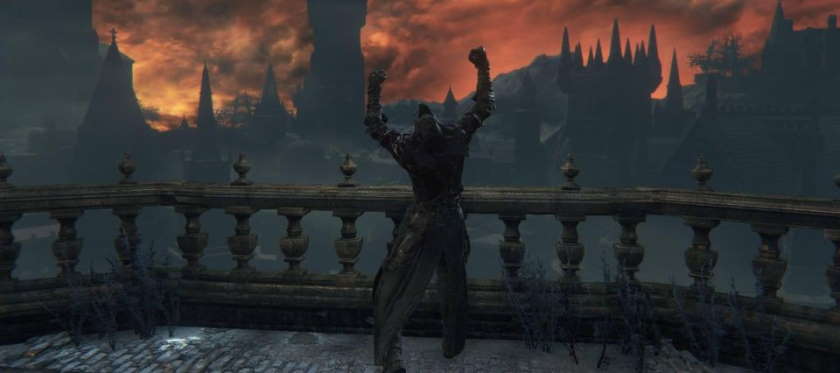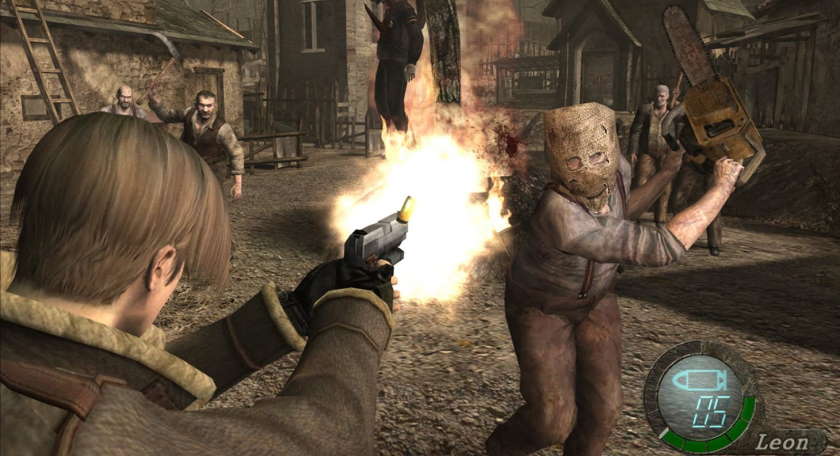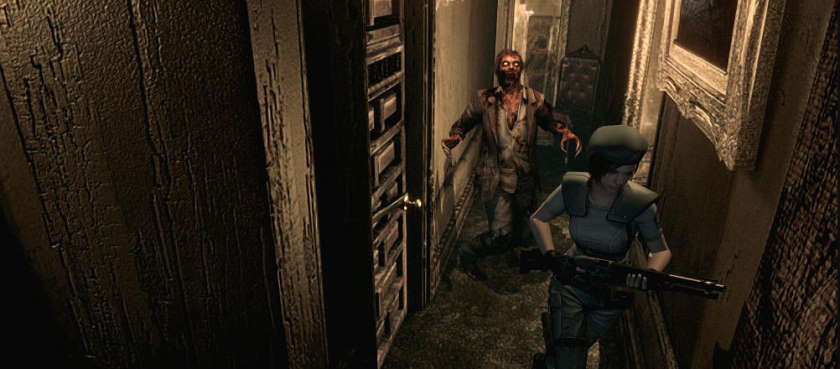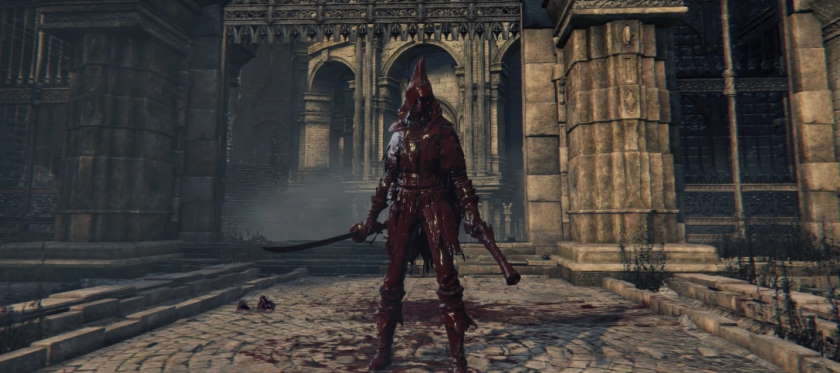Action-Horror, Bloodborne, and the Shortcomings of Game Genre

My outrage to someone claiming a game is “like Dark Souls” just because it is difficult is about as predictable as the comparison itself. I never got far in either Demon or Dark Souls, and while I managed a few hours progress in Sekiro: Shadows Die Twice I found myself increasingly angry at the game’s many flaws. People had always described From Software’s design philosophy as “harsh but fair”, yet I found nothing fair in handicapping the player with a framerate of 30FPS while demanding such precision timing. The uncanny ability for enemies to pivot mid-animation, following your every movement regardless of their initial target, is the very definition of unfair. As a stealth game, Sekiro was fine. As an action game, it was a dominatrix demanding I lick the dirt from its stiletto heels and I’m sorry but masochism was never really my kink.
It was with some trepidation, then, that I acquiesced to my friend’s demands to try Bloodborne, From Software’s PlayStation 4 exclusive of the same “genre”. Like its brethren you’re expected to die almost immediately in order to learn a lesson about the cruelty of the world as well as death not being the end. Death does, however, come with a cost. Any of the precious currency used to gain levels and increase stats is lost. It’s possible to retrieve said currency, but should you die on the way back to your lost treasure or during retrieval, they will be lost permanently With few exceptions, all slain monsters and malcontents are only temporarily deceased. Any step into a sanctuary location immediately resurrects the defeated, meaning victory is fleeting.
It should be noted that I enjoyed games with similar mechanics. I absolutely loved Darksiders III once I had adjusted to the more threatening atmosphere, learning to “kite” or “aggro” enemies so that I could defeat them alone rather than in a group. Hollow Knight also drops all gained currency upon death, though with the added twist of reducing your total spiritual or magic power until you’ve defeated the dark spirit of your old corpse in combat. More recently I’ve played Star Wars: Jedi: Fallen Order which imitates the manner foes respawn into the world upon resting at a sanctuary.
It’s clear that I’m not completely opposed to certain mechanics found in From Software’s titles. In fact, should I play more of Bloodborne I may have more thoughts regarding why I’m so taken by it compared to the other titles. Yes, that’s right, I am indeed enjoying Bloodborne despite dropping the rest of the games with a deep sense of apathy or, in the case of Sekiro, absolute frustration. For now, however, I’d instead like to focus on the peculiar concept of “genre” and how it fails to illustrate the actual feel of a game. You see, yesterday morning, watching a crazed old lady jam a sickle into my character’s poor mutilated face repeatedly, I was struck by an epiphany:
Playing Bloodborne is a lot like playing a Resident Evil game.

Looks like Leon’s about to lose his head.
The similarities were purely aesthetic at first. The sight of a horde of dirt-smothered villagers charging at me with torches and pitchforks brought to mind multiple set pieces from Resident Evil 4. By time I reached the village of Hemwick I was expecting cries of “Un Forastero!” to burst from the cultists dancing around a bonfire. The two games share a similar rustic aesthetic and color palette, resulting in a shared atmosphere between them.
To simplify this similar feel between the two games would be doing the deeper mechanical similarities a disservice. Resident Evil 4 is just as prone to enemies hiding around a corner, waiting to ambush unsuspecting players that fail to look before leaping. Each game is littered with opponents capable of taking out the player in a single blow. Large arenas with equally large monstrosities test the player’s skill and patience. Subtle strategies can be used to stun one’s opponent before finishing them swiftly and cleanly.
Leon may be equipped with an arsenal of firearms rather than blades, but there’s more than enough similarity in each game’s design to draw atmospheric, mental, and emotional comparisons. The most significant ways the two games differ is in their handling of death and cleared zones. Resident Evil 4 has the more traditional game over screen, resulting in completely lost progress. All items and money obtained since the last save point are gone and must be retrieved once more. In some ways Bloodborne is more forgiving, retaining item drops and any unlocked shortcuts forward regardless of the last time you fled to the Hunter’s Dream. Even if you must replay a section you’ll retain a percentage of your progress. It’s your currency that is at risk of running out, and even that can be recovered.
However, should the player succeed in clearing out so much of a zone in Resident Evil 4 without dying, they are largely free to backtrack and save at any time. New enemies are only spawned in upon reaching certain narrative milestones. Otherwise, all areas will remain empty once the enemy occupants have been slain.
Of course, that safety is only a slight mechanical difference between titles. As long as the player progresses forward, any territory they must return to will change. They will populate with a new collection of foes, their ranks sometimes strengthened by new and more powerful monsters. While this is in part done in order to keep the player engaged, it is also done to keep the player from feeling too safe. They are a stranger in a strange and unknown land. No matter how calm the world becomes, there should always be a sense that something very unsettling is going on.

That’s funny, I could have sworn that undead was dead an hour ago.
This is not unlike the Resident Evil remake that preceded it, where the Crimson Head transformation was added to ensure that even inactive zombies were to be feared. Even so, by lighting many of the corpses on fire, the player could plan out safe routes to travel the mansion, avoiding any rooms or hallways that may result in a hazardous run-in with the undead. The oppressive threat of what lies within the mansion swiftly changes to comfort and familiarity, the antithesis of a horror experience. It is for this reason that the reptilian Hunters are introduced halfway into the game, populating many of the rooms and chambers that had once been cleared out. The player’s safety blanket is torn away from them as the Spencer Mansion becomes a deadly home once more.
The same can be said for Mr. X in the Resident Evil 2 remake, disrupting the player’s journey into the Raccoon City Police Department just as they begin to grow familiar with the place. In order to maintain that essence of horror, each of these games insert a modification into the game world so that the player may remain on their toes.
It is for this reason that Bloodborne revives the world’s monsters with each trip to the Hunter’s Dream. You’re not supposed to feel comfortable in Yharnam or Hemwick, or any location throughout the game’s world. This is an unnaturally long night in which horrifying monsters and beasts roam free, slaughtering any civilians that dare wander into the streets. If the enemies stayed dead, then the world would begin to feel safe.
I had attempted the Resident Evil 3 demo before I had even spun the Bloodborne disc into my PS4’s drive. Just as I later would explore Yharnam, I spent my time in Raccoon City creeping forward, looking around corners to try and spot any undead in hiding, slowly inching my way through the environment. The only difference is that, in Yharnam, I was more willing to fight nearly every opponent that came my way. There were times I screwed up and needed to hurriedly heal myself, but I was cautious enough that my screw-ups were few and the fallen bodies left in my wake piled high.
Much like Resident Evil 4.

Being so drenched in blood is simultaneously empowering and horrifying, which accurately embodies much of the feeling of playing this game.
I make these comparisons because, just as I said at the start of this essay, I am exhausted of constant comparisons to the “Soulsborne” genre. It seems to me that a healthy host of bloggers, games pundits, and forum posters are eager to apply the label or comparison to any game that dares be difficult. Yet now that I’ve begun to play Bloodborne and understand the feelings it stirs within me being the same as Resident Evil 4, I understand that it is, in part, a failure on the game industry’s part to properly classify game genre by the emotional response they evoke from a player.
Though their mechanics are very different, both Resident Evil 4 and Bloodborne evoke the same feelings of both nervous terror and triumphant empowerment. Both games encourage and reward combat in ways other horror games do not. While their visual aesthetic and presentation is no doubt a contributor to the shared sense of dread and discomfort, the gameplay itself encourages the player to behave in similar ways: cautious, but courageously.
To contrast, Star Wars: Jedi: Fallen Order imitates the manner in which enemies are respawned into the world, but nothing about the game is terrifying. Cal is always presented as a far more capable and acrobatic warrior, and the quantity of lethal, powerful foes is limited in early parts of the game. The first time the player is up against an AT-ST, they are able to lob grenades right back into it. In time, the player will be able to snatch Stormtroopers through the air before skewering them upon his lightsaber. It is a world where Cal looks upon the land from atop a giant bird, admiring the natural beauty of Wookie homeworld Kashyyk.
So… what good does it do to have enemies respawn each time you rest? How does that decision fit with the game’s vision of a force user?
This is the problem with throwing terms like “Soulsborne” around so casually. People begin to mistake the mechanics themselves for the quality, rather than identifying the deeper ways each mechanic interlocks with one another to convey a tone and atmosphere. If you wish to make a game world threatening, you don’t need to have a sanctuary location that respawns enemies to do it. Nor do you need to have a Mr. X wandering your game world. These are solutions to a simple question: “how do we keep the player from feeling to safe, comfortable, and secure? How do we keep the world from becoming too familiar?”
I still have further to go in Bloodborne, but I’ve already seen subtle ways in which the world has transformed. New foes have spawned in places that were previously vacant. Other enemies whose patrols I had memorized are suddenly nowhere to be seen – a unique method of instilling fear, as what should have been a relief became an unnerving change from expectation.
To this end, I classify Bloodborne quite simply as an action-horror, just as I do Resident Evil 4. The games play very differently, but evoke similar emotions. Does this mean fans of one will enjoy the other? Quite possibly, but no two products are exactly alike. I do, however, think there’s more reason to believe fans of Resident Evil 4 will enjoy Bloodborne – and vice versa – than fans of Bloodborne will enjoy Sekiro.
I, of all people, should know.


